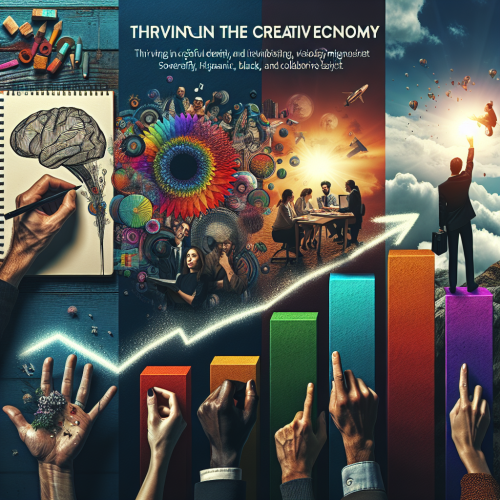Creative Economy – When I first started out in the creative economy, I’ll be honest—I had no idea what I was doing. It felt like I was just tossing things out into the void and hoping something would stick. As a writer, designer, and general creative type, the transition from a traditional 9-to-5 job to the world of freelancing and creative entrepreneurship was a steep learning curve. But looking back, I’ve picked up a few essential lessons that can help anyone thrive in this space. And trust me, it’s not just about talent—it’s about being strategic, adaptable, and knowing where to put your energy.
So, if you’re feeling a little overwhelmed or unsure, here are five essential tips that I’ve learned the hard way. These are the lessons that helped me build a solid foundation and, eventually, grow my creative business.

Table of Contents
ToggleHow to Thrive in the Creative Economy: 5 Essential Tips
1. Build a Strong Personal Brand
This one took me a while to fully understand, but it’s easily one of the most important aspects of thriving in the creative economy. When you’re working in a space that’s flooded with talent and competition, it’s easy to get lost in the crowd. It’s not enough to just be good at what you do—you’ve got to stand out.
For me, it started with figuring out what I wanted my personal brand to represent. Was I a quirky, fun designer, or more of a minimalist who focuses on simplicity? Once I figured that out, I started sharing my process, my work, and my ideas more consistently on social media and my website. Over time, I started attracting the kind of clients and opportunities that matched my style.
A strong personal brand isn’t just about your logo or the colors you choose. It’s about your voice, your message, and the story you tell. It’s what makes you relatable and memorable. Now, I can’t tell you how many times someone has reached out because they felt connected to my brand or liked the way I explain things. That connection is key in the creative economy.
Tip: Take the time to define your brand. What sets you apart? And more importantly, what value do you bring to the table that others might not?
2. Never Stop Learning and Evolving
The creative economy is always shifting. Trends change, tools evolve, and your skill set has to keep up. There was a time when I thought I knew everything I needed to know about design and writing. Spoiler alert: I didn’t. I got comfortable, and it almost cost me some big opportunities.
A few years ago, I noticed that a lot of my peers were jumping into new technologies like AI and augmented reality, while I was still holding onto my old-school design techniques. Don’t get me wrong, there’s nothing wrong with traditional skills, but I realized that by sticking only to what I knew, I was limiting myself.
So, I decided to take some online courses, attend webinars, and even pick up new hobbies just to stretch my creativity in different ways. Sure, it was a bit uncomfortable at first, but it helped me stay relevant in an industry that’s constantly evolving.
Tip: Never stop learning. Whether it’s picking up a new skill, diving into a new platform, or staying up to date with industry news, always look for ways to grow.
3. Network, But Don’t Just Network for the Sake of It
Networking is often seen as the magic key to success, but here’s a truth bomb: not all networking is created equal. Early on, I was trying to network with everyone and anyone, hoping that it would lead to a breakthrough moment. But honestly? A lot of those connections were shallow, and they didn’t lead anywhere.
It wasn’t until I started being more intentional about the people I networked with that things began to click. Instead of chasing every opportunity, I focused on building real relationships with people who shared my values or interests. It wasn’t just about getting clients—it was about building a community of like-minded creatives who supported each other.
One of the best things I did was attend industry events and conferences, not with the goal of “selling” myself, but to simply meet people and learn from them. Some of those relationships have turned into lifelong friendships, and others have become business collaborations. It’s about finding your tribe.
Tip: Focus on quality over quantity when it comes to networking. Build authentic relationships with people who genuinely align with your creative vision.
4. Set Clear Boundaries and Manage Your Time Wisely
If there’s one mistake I’ve made that I see others make all the time, it’s not setting clear boundaries. When you’re your own boss, it can be easy to say “yes” to everything. At first, I thought the more projects I took on, the better off I’d be. But eventually, I found myself stretched thin, working late nights, and feeling burnt out. It’s not sustainable, and it doesn’t make for great work either.
The key to thriving in the creative economy is learning how to say “no” and set boundaries that protect your time and energy. I started setting specific hours for work, so I knew when to turn off and recharge. And I also learned to evaluate potential projects based on whether they aligned with my long-term goals.
Tip: Learn to say no when necessary. Protect your time, and don’t be afraid to turn down projects that aren’t the right fit.
5. Don’t Be Afraid to Collaborate
When I first got started, I thought that being a creative meant doing everything on my own. But I quickly realized that collaboration is one of the best ways to grow and expand your reach. Whether it’s teaming up with other creatives on a project or working with a business partner, collaboration can open doors that would otherwise remain closed.
One of the most successful projects I worked on came from a collaboration with another writer and designer. We combined our strengths and created something that was way beyond what either of us could have done alone. Plus, we shared our networks, which brought in even more clients.
Tip: Don’t be afraid to reach out to others for collaboration. Sharing ideas and combining your expertise can lead to amazing results.
Wrapping It Up
The creative economy is an exciting place to be, but it’s not always easy. It requires persistence, adaptability, and a willingness to take risks. But with the right mindset, strategies, and a little bit of hustle, you can not only survive but thrive in this space. Build a personal brand that speaks to your uniqueness, continue learning, network with intention, set boundaries, and embrace collaboration. Follow these five tips, and you’ll be on your way to finding success in the creative world!





